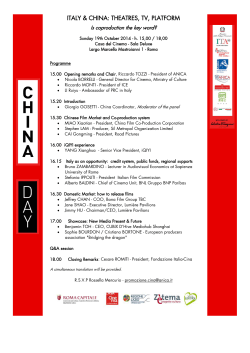
CINEMA - movieomagic.com
14 Community Wednesday, February 11, 2015 CINEMA TWO GOOD: Filmmaker Girish Kasaravalli’s (right) 90-minute documentary on Adoor Gopalakrishnan, titled Images and Reflections: A Journey into Adoor’s Imagery, is complete. Photo credit: Amit Agarwal A rare chronicle By Gautaman Bhaskaran W hen two giants in the art of entertainment get together, it is certainly magic. In the fall of 1962, whilst The Birds was in post-production, François Truffaut had extensive interviews with Alfred Hitchcock at his office in Universal Studios. The interviews were recorded on audio tape and the content of about 50 hours was edited and used in a book which Truffaut wrote on the master of the macabre. There are hardly any giants in Indian cinema today. Two of the remaining few are Adoor Gopalakrishnan (whose last film, Oru Pennum Rendaanum, in Malayalam came in 2008) and Girish Kasaravalli (Koormavatara in Kannada was his last in 2012). And when one makes a documentary on the other, it is bound to be fascinatingly insightful. Except for a day’s schedule, Kasaravalli’s 90-minute documentary on Gopalakrishnan, titled Images and Reflections: A Journey into Adoor’s Imagery, is done. Kasaravalli told me over the telephone from Bangalore that the movie was wrapped up in four schedules, each a week long. “I went along with Adoor to some of the places that have been strongly associated with him”. One of them was Pallickal in a remote corner in Kerala where Gopalakrishnan was born in 1941 -- times of great political upheaval in India. Gopalakrishnan’s house in Pallickal, called Medayil, was a palatial two-storey building that seemed to rise majestically out of lush paddy fields and coconut groves. A structure such as Medayil was uncommon, a virtual novelty, in those days, and people from far away came to have a glimpse of it. I can picture a scene where passers-by would have stopped to stare – and been awestruck. I remember a somewhat similar curiosity that Chennai’s (Madras then) 14-storey Life Insurance Corporation building evoked once. Probably once the tallest in South India, it was a landmark that attracted visitors from neighbouring towns and villages. Another place that Kasaravalli took Adoor for the documentary was Alappuzha -- the scenic backwater town of Kerala’s Allepey district now renowned for houseboat tourism—where the auteur shot two of his films, Naalu Pennungal in 2007 and Oru Pennum Rendaanum. Alappuzha exhibits a placid calm which is occasionally disturbed by a slow moving boat. In Naalu Pennungal, the boat appears time and again as a motif. For Gopalakrishnan, the boat and the river are part of his indelible memory that he carries from his childhood, when he stood watching a priest pass by in a tiny boat every morning. While invariably most people adore Kasaravalli with the filming crew. Gopalakrishnan’s Elippathayam and Vidheyan (with Mammootty rivetingly essaying a brute tax collector), Kasaravalli averred that his two favourite movies in the Adoor oeuvre were Anantaram and Mukhamukham. The first analyses the life of a young man, Ajayan, and how his multi-faceted talents are camouflaged by his psychiatric disorder. Does a gifted mind fall prey to this disease? I wonder. An example that comes readily to my mind is mathematical wizard John Nash, whose lifelong struggle with schizophrenia was made into a gripping celluloid work by Ron Howard in 2001. Also, I remember some people from my childhood, people who were brainy, but eventually suffered from this debilitating mental illness. Over a period of time, Ajayan finds that he cannot distinguish between fact and fiction: his beautiful sister-in-law, Suma transforms into Nalini in his hallucinating mind. She becomes his lover, till he accuses her of marital infidelity, cheating on his brother-inlaw Balu. Ajayan loses interest in life, misses his college lectures and lies about in his unkempt hostel room. He appears shabby and angry, his eyes often blood shot. Mukhamukham caused controversy. Of the most virulent kind. The film opened in 1984 in a Kerala where politics was big business. It was even big entertainment. Then, and even now. And, everybody watched everybody, and the state being small this was not so difficult. It happens even now. And Gopalakrishnan was well known by then. He was three features old when Mukhamukham began its run. It was at once perceived as an anti-Communist movie and severely panned, and strangely, much of the criticism was sparked by a simple human behaviour. Protagonist Sreedharan turns an alcoholic in the second half of the movie. So what, one may ask. Millions of men and women the world over get addicted to something or the other. Yes, but the Communists did not want Sreedharan to be shown as a drunkard. For, he was not just a party cadre, but also a trade union leader on the screen. That, the Red Brigade felt, was bad publicity for a people’s movement like theirs! Adoor had explained then that Mukhamukham was not a political work. “It is more humanist, less political,” he wrote in Cinema Anubhavam in order to try and quell all those allegations against him. Kasaravalli may not have courted as many controversies as Adoor has, but Girish’s cinema has been equally powerful, often seen as a great documentation of the Kannada society. His first feature-length documentary in 75 minutes, Ananthamurthy: Not A Biography But A Hypothesis, which opened two years ago, engaged us with interesting observations on the life and times of this great social thinker. Part of the New Indian cinema that began in 1969 with Bhuvan Shome, Kasaravalli walked into the genre eight years later with his brilliant Ghatashraddha — a haunting study of society with a young pregnant widow as a protagonist. He has made 14 features, and among them Tabarana Kathe, Mane and Gulabi Talkies continue to remain the most sought after and the most discussed. z Gautaman Bhaskaran has written a biography of Adoor Gopalakrishnan, and may be e-mailed atgautamanb@hotmail.com
© Copyright 2025









